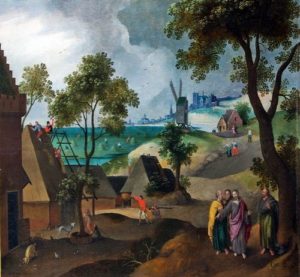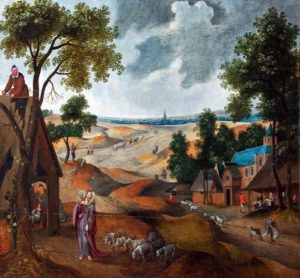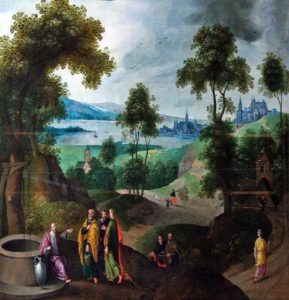Chapelle Notre-Dame de Montfaucon is at the western edge of the town. It is a large 16thC building which was restored in the 19th and 20thC. Outside is a sign about the exhibition of pictures in the church by Abel Grimer 1592. There are twelve paintings representing the twelve months of the year. They were brought to Montfaucon by Father Jamon when he became priest here. The cover profane scenes of ever day 16thC life with religious scenes from the life of Jesus or the parables. Each is signed by Abel Grimer and there is a biblical reference in the right hand corner.
We don’t usually ‘do’ paintings but were fascinated by these, particularly the intimate details of daily life.
The sequence begins in December with the arrival at the inn. The scene is set in a small town with a square with a church and well. People are going about their business and there is an oxen cart. At the front some townsfolk are admiring four turkeys.
January tells of the dream of Joseph and the flight into Egypt. It is a snow scene with people gathering branches from a tree for firewood and the Holy Family on a donkey.
February is the calling of the first disciples. This is a fishing scene with fishing boats and men carrying the fish into the town, a splendid place with a large gateway.
March shows the planting of the vines. Jesus is with three people in 16thC dress watching the planting of vines. In the background is a castle on a hill with a town beyond with boats.
April is the parable of the sower This is a rural scene with a person ploughing with two horses and the sower scattering seed by hand on the ploughed ground. In the castle garden, the gardeners are busy at work.
May tells the story of the Samaritan woman who had been so busy listening to Jesus at the well she had forgotten to take her water jug. The disciples are bringing food from the town for Jesus. In the background is a scene of trees and fields with the town with church tower in the distance and a castle on a hill.
June is the parable of the Good Shepherd. Jesus is with a flock of sheep and is carrying a sheep round his neck. In the background sheep are being sheared under a shelter and bags of wool are being taken to the town.
July warns against the dangers of materialism and avarice. In the bottom corner is Jesus with three men. In the background, seaweed is being harvested and a roof being thatched. A man is sitting under a tree taking it easy with a dog, pigs and hens around him.
August is about the harvest and the parable of the sabbath. The wheat is being cut, laid out to dry and piled onto a cart. In the background is a windmill.
September is the parable of the sterile fig tree. This shows a harvest scene with apples being collected from trees in an orchard and taken back to the town. There is a splendid moated castle. October has a scene of the homicide of the wine growers. The servants have chased the owner’s son out of the vineyard set on the slopes beneath the castle and have killed him.
November is the wedding of the king’s son. Preparations for the feat are underway with a cow being dragged to slaughter across the castle courtyard. After the rich friends have declined to come, the king is sending out his servants to find beggars and cripples to invite in their place. Below the castle is a small town with a windmill on the hill behind and another town in the background.
The chapel is a large building with the pictures arranged in sequence round the walls of the nave. There is a decorative pink/beige frieze above then and a narrow pattern round the windows. There are flat pillars against the walls which have carved capitals and support the ribs of the vaulted ceiling. The ribs of the chancel vault are painted in gilt and pink.
There is a large 16thC marble altar with an elaborately carved base and retable. The altar base has pillars of different coloured marbles. The retable is designed to look like the front of a church with pinnacles and a large spire above the host box. Gilt angels on either side hold lamps. This has a gilt door with the figure of Christ on it. Above is an illuminated statue of the Virgin and Child. This is carved from stone and the Virgin is dressed in a white dress with gold embroidery. On either side of the altar are free standing white barleycorn twist pillars with carved and painted trailing grapes on them which act as flower stands.. There is tall wooden panelling around the walls with wooden choir stalls.
The north transept has a white carved marble altar with cameos on a dark gilt background. There is a statue of St Ann with the young Mary under the spire of the retable. There are statues of St Theresa and St François Regis on either side. The stained glass window has the Virgin and Child with Adam and Eve below.
The south transept altar is similar but has a statue of Joseph with the young Jesus, flanked by St Antoine de Padoue and Joan of Arc. The window has Joseph above a scene of Jesus raising Lazarus from the dead.
This was a completely unexpected find. We’d only stopped in Monfaucon-en-Velay to buy bread and to let early morning mist clear. There is little about the paintings in the guide books or on the web. In fact web sites concentrate more on the the carved statue of the Virgin and child on the altar. This is well worthwhile finding.










